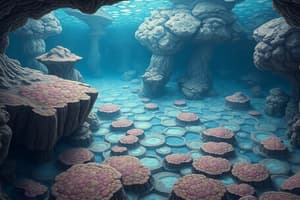Podcast
Questions and Answers
What role did cyanobacteria play in Earth’s early atmosphere?
What role did cyanobacteria play in Earth’s early atmosphere?
- They converted nitrogen into oxygen.
- They significantly increased atmospheric oxygen levels. (correct)
- They contributed to the depletion of atmospheric oxygen.
- They had no effect on atmospheric conditions.
Which statement about stromatolites is true?
Which statement about stromatolites is true?
- They are formed primarily by the activity of fungi.
- They are exclusively found in Paleozoic rocks.
- They contain cyanobacteria fossils. (correct)
- They are flat structures with no layering.
Which of the following metals is rare and commonly found in meteorites?
Which of the following metals is rare and commonly found in meteorites?
- Copper
- Iridium (correct)
- Platinum
- Gold
What event is marked by the presence of iridium bands at the K-T boundary?
What event is marked by the presence of iridium bands at the K-T boundary?
During which eon did the majority of Earth's history occur before complex life emerged?
During which eon did the majority of Earth's history occur before complex life emerged?
Which of the following statements about the Mesozoic Era is correct?
Which of the following statements about the Mesozoic Era is correct?
What characteristic of iridium makes it suitable for applications like satellites and spark plugs?
What characteristic of iridium makes it suitable for applications like satellites and spark plugs?
Which statement about the Phanerozoic Eon is true?
Which statement about the Phanerozoic Eon is true?
Flashcards are hidden until you start studying
Study Notes
Stromatolites
- Structures formed by cyanobacteria
- Layered due to the activity of cyanobacteria
- Cyanobacteria are photosynthetic, producing energy from sunlight
- Cyanobacteria have tough, multilayered cell walls that aid in fossilization
- Cyanobacteria played a key role in raising atmospheric oxygen levels during Earth's early history
Geologic Time Scale
- Precambrian: 4.5 billion years ago (bya) to 550 million years ago (mya)
- Includes Hadean, Archean, and Proterozoic Eons
- Represents the majority of Earth's history before complex life
- Phanerozoic Eon
- Paleozoic Era: 550 mya to 250 mya
- Began with the Cambrian Explosion, leading to rapid diversification of life
- Includes Cambrian, Ordovician, Devonian, Carboniferous, and Permian periods
- Ended with the Permian Extinction, causing the loss of 95% of species
- Mesozoic Era: 250 mya to 65 mya
- Dominated by dinosaurs
- Periods include Triassic, Jurassic, and Cretaceous
- Ended with the K-T Extinction, resulting in the loss of 80% of species, including dinosaurs
- Cenozoic Era: 65 mya to present
- Includes Paleogene, Neogene, and Quaternary periods
- Marked by the rise of mammals and the development of human life
- Paleozoic Era: 550 mya to 250 mya
Iridium
- Found in bands at certain extinction event boundaries, like the K-T boundary
- Rare metal on Earth but common in meteorites
- Highly dense, resistant to erosion, and can withstand high temperatures (up to 2,000°C)
- Used in satellites, spark plugs, and decorative items due to its durability and rarity
Studying That Suits You
Use AI to generate personalized quizzes and flashcards to suit your learning preferences.




